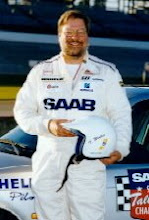It has been a few years since the last post on the Fart-hinder Racing team blog. After the engine failure at BIR in 2017, the engine was replaced with a rebuilt unit, which lasted only six laps at Road America. Since Mark Fitzpatrick's Miata seemed reliable and competitive in its class, with several first place finishes, the racing effort turned its concentration to the Mazda.
The ex-Cougar Bait, now ex-Fart-hinder Saab was sold to rbankracing. At its first outing at Daytona in 2018, it ran in the top ten until a loose fitting in the fuel system put it behind the wall for many laps. At the following race at Watkins Glen, the ex-Fart-hinder Saab 9-3 won overall in the rain at Watkins Glen. We always assumed that car could be competitive overall, we just didn't have the mechanical knowledge to fine tune it properly. It was the first of several first place finishes for that Saab at the hands of rbankracing.
It was time to turn attention once again to the 1960 SAAB 93F in the barn. The ex-ice racer had a bit of work done to it since Tim acquired it in 1991, but very little.
With help from Tony Israelson, the engine fired to life for the first time in ages in August 2012.
Tom Donney had written about early Saab brakes and posted the information on his web site.
http://www.tomdonneymotors.com/2008/11/03/wheel-cylinders/
Tom referred to the different early Saab braking systems as:
Type I called Shitty, Shitty, Shitty
Type II called Shitty, Shitty
Type III called just Shitty.
In truth, there are other variations in wheel cylinder bore, NPT or British threads on the cylinder and brake lines (which necessitates the use of Whitworth trenches), and brake drum size. It was also possible that a former owner might have used whatever he had available that wasn't exactly correct, but would work okay.
Ultimately I was able to deduce that what I needed was the same as an MG-TD (or maybe it was MGA, which would make more sense because it was in production at the same time as the 1960 Saabs). This didn't surprise me as Saab, being a small company, often used off-the-shelf parts from some other car. Lockheed-Girling made brakes for many manufacturers in those days. I was able to order what I needed from Moss Motors. Installing the new wheel cylinders went pretty smoothly, though removing and re-installing the brake drums was, as usual on those old Saabs, a pain in the butt.
While I was at it, I also replaced the master cylinder with one from some old GM model. That's what was on the car when I bought it, replaced long ago to prep the car for ice racing. I also decided to replace the steel brake lines, at least up front. That meant buying generic length brake lines, bending them to match the existing lines, then cutting and flaring the ends, using the old connectors. Once the job was done, the brakes took several pumps to properly pressurize. I surmised that I had pinched one of the lines while bending it.
Fart-hinder race car projects took precedence in the garage, so the 93F was put aside again for a few years.





